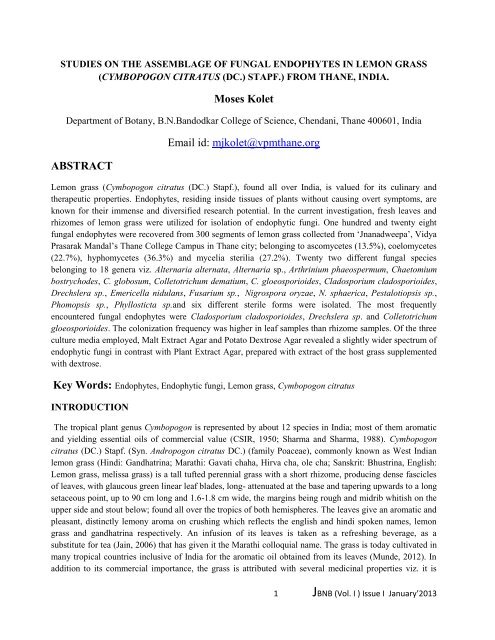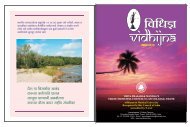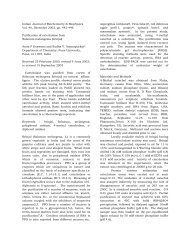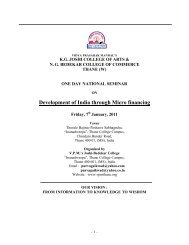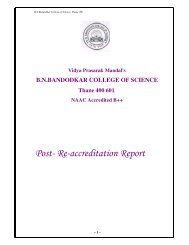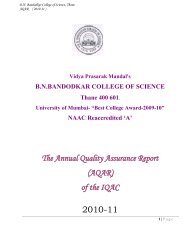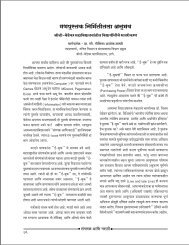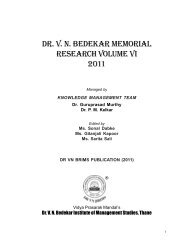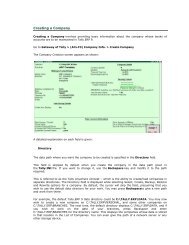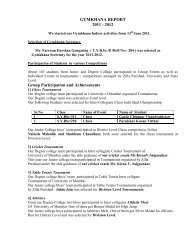J-BNB - VPMThane.org
J-BNB - VPMThane.org
J-BNB - VPMThane.org
Create successful ePaper yourself
Turn your PDF publications into a flip-book with our unique Google optimized e-Paper software.
STUDIES ON THE ASSEMBLAGE OF FUNGAL ENDOPHYTES IN LEMON GRASS<br />
(CYMBOPOGON CITRATUS (DC.) STAPF.) FROM THANE, INDIA.<br />
Moses Kolet<br />
Department of Botany, B.N.Bandodkar College of Science, Chendani, Thane 400601, India<br />
ABSTRACT<br />
Email id: mjkolet@vpmthane.<strong>org</strong><br />
Lemon grass (Cymbopogon citratus (DC.) Stapf.), found all over India, is valued for its culinary and<br />
therapeutic properties. Endophytes, residing inside tissues of plants without causing overt symptoms, are<br />
known for their immense and diversified research potential. In the current investigation, fresh leaves and<br />
rhizomes of lemon grass were utilized for isolation of endophytic fungi. One hundred and twenty eight<br />
fungal endophytes were recovered from 300 segments of lemon grass collected from ‗Jnanadweepa‘, Vidya<br />
Prasarak Mandal‘s Thane College Campus in Thane city; belonging to ascomycetes (13.5%), coelomycetes<br />
(22.7%), hyphomycetes (36.3%) and mycelia sterilia (27.2%). Twenty two different fungal species<br />
belonging to 18 genera viz. Alternaria alternata, Alternaria sp., Arthrinium phaeospermum, Chaetomium<br />
bostrychodes, C. globosum, Colletotrichum dematium, C. gloeosporioides, Cladosporium cladosporioides,<br />
Drechslera sp., Emericella nidulans, Fusarium sp., Nigrospora oryzae, N. sphaerica, Pestalotiopsis sp.,<br />
Phomopsis sp., Phyllosticta sp.and six different sterile forms were isolated. The most frequently<br />
encountered fungal endophytes were Cladosporium cladosporioides, Drechslera sp. and Colletotrichum<br />
gloeosporioides. The colonization frequency was higher in leaf samples than rhizome samples. Of the three<br />
culture media employed, Malt Extract Agar and Potato Dextrose Agar revealed a slightly wider spectrum of<br />
endophytic fungi in contrast with Plant Extract Agar, prepared with extract of the host grass supplemented<br />
with dextrose.<br />
Key Words: Endophytes, Endophytic fungi, Lemon grass, Cymbopogon citratus<br />
INTRODUCTION<br />
The tropical plant genus Cymbopogon is represented by about 12 species in India; most of them aromatic<br />
and yielding essential oils of commercial value (CSIR, 1950; Sharma and Sharma, 1988). Cymbopogon<br />
citratus (DC.) Stapf. (Syn. Andropogon citratus DC.) (family Poaceae), commonly known as West Indian<br />
lemon grass (Hindi: Gandhatrina; Marathi: Gavati chaha, Hirva cha, ole cha; Sanskrit: Bhustrina, English:<br />
Lemon grass, melissa grass) is a tall tufted perennial grass with a short rhizome, producing dense fascicles<br />
of leaves, with glaucous green linear leaf blades, long- attenuated at the base and tapering upwards to a long<br />
setaceous point, up to 90 cm long and 1.6-1.8 cm wide, the margins being rough and midrib whitish on the<br />
upper side and stout below; found all over the tropics of both hemispheres. The leaves give an aromatic and<br />
pleasant, distinctly lemony aroma on crushing which reflects the english and hindi spoken names, lemon<br />
grass and gandhatrina respectively. An infusion of its leaves is taken as a refreshing beverage, as a<br />
substitute for tea (Jain, 2006) that has given it the Marathi colloquial name. The grass is today cultivated in<br />
many tropical countries inclusive of India for the aromatic oil obtained from its leaves (Munde, 2012). In<br />
addition to its commercial importance, the grass is attributed with several medicinal properties viz. it is<br />
1 J<strong>BNB</strong> (Vol. I ) Issue I January’2013


